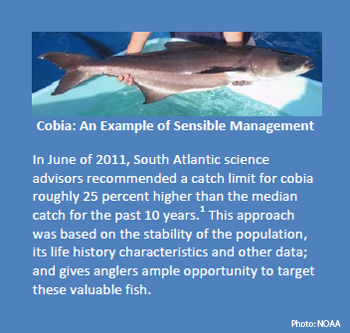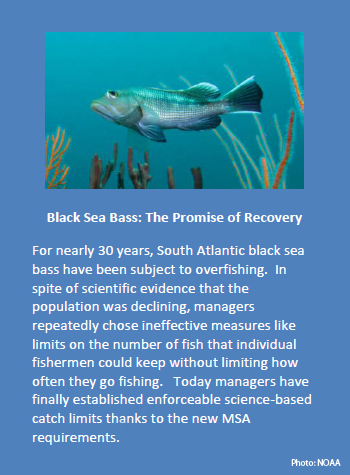Science-Based Management of America's Ocean Fish: A Growing Success Story
The United States is on the verge of completing a new science-based management system for ocean fish that will ensure sustainable fisheries. Congress should support managers as they achieve this goal, which will deliver an enduring legacy of healthy fish populations and thriving fishing businesses.
 America's ocean fish populations were once thought to be virtually limitless, but decades of overfishing (taking fish faster than they can reproduce) proved this wrong. The country is still recovering from the impacts of a failed management system with few limits and little accountability that depleted fish populations and lost jobs.
America's ocean fish populations were once thought to be virtually limitless, but decades of overfishing (taking fish faster than they can reproduce) proved this wrong. The country is still recovering from the impacts of a failed management system with few limits and little accountability that depleted fish populations and lost jobs.
In 2006, Congress reauthorized America's ocean fishing law, the Magnuson-Stevens Fishery Conservation and Management Act (MSA), and required the establishment of science-based annual catch limits and accountability measures for all U.S. ocean fish populations to end and prevent overfishing within five years. Scientists and managers have utilized a suite of scientifically-rigorous methods to put the U.S. on track to achieve this precedent-setting mandate by the end of 2011.
Fisheries science has advanced significantly since 2006, driven by the catch limit requirement.
More information is available today about U.S. ocean fish populations and fishing impacts than at any point in history. In developing science-based limits, managers and scientists around the country demonstrated that scientific information is available for all federally-managed fish and that there are scientifically-rigorous methods available to set annual catch limits for every U.S. ocean fish population.
The science-based approaches that are being used to set catch limits effectively around the country when information is limited include:
- Hold fishing near recent catch levels until more complete scientific evidence indicates that the population can support additional fishing.
- Set more careful limits for fish species that are susceptible to overfishing because they recover more slowly due to biological factors such as slow growth rates and low reproductive output.
- Group multiple fish populations with similar biological characteristics and use one as an "indicator species" to establish the appropriate catch limit for the group.
Ocean fish conservation creates jobs and income.
The economic benefits of setting science-based catch limits are only beginning to be realized as fish populations rebound. In the Mid-Atlantic, overfishing has ended and once-depleted species like bluefish and summer flounder are thriving and supporting increased fishing levels.2 Gulf of Mexico red snapper were depleted by historic overfishing, but today they are recoving and expanding in size, abundance and geographic range.3 Overall, U.S. commercial and recreational fishing generated $166 billion in sales and supported nearly 1.4 million jobs in 2009.4 The new science-based management system protects the valuable ocean fish populations which provide these benefits, and creates a responsible approach for expanding fishing effort in the future. The estimated economic value of rebuilding all U.S. fish populations to healthy levels includes a $31 billion increase in annual sales and support for 500,000 new U.S. jobs.5
Unfortunately, just as the U.S. is ready to complete science-based catch limits that will ensure sustainable fisheries, a bill (H.R. 2304) has been introduced in Congress that threatens to derail process by exempting fish populations from catch limits if they lack recent full assessments. Rather than support this bill that would remove some of America's most valuable and vulnerable fish from science-based management, Congress should invest in improving our scientific improvements by funding data collection and monitoring programs. These programs increase the precision of management so that fishing opportunities can be maximized while protecting the resource.
The Magnuson-Stevens Act is working. Congress should remain steadfast in its support of the MSA and support the science-based management system that protects the ocean fish populations that provide jobs, income and seafood for millions of Americans.
Sources:
1. South Atlantic Fishery Management Council (SAFMC), Science and Statistical Committee Meeting Report, April 2011, www.safmc.net/LinkClick.aspx?fileticket=jQTEjW5ZgbM&3D&tabid=681.
2. National Marine Fisheries Service (NMFS), "2011 Status of U.S. Fisheries: First Quarter Update," March 2011, www.nmfs.noaa.gov/sfa/statusoffisheries/SOS.main.htm.
3. Gulf of Mexico Fishery Management Council, Stock Assessment of Red Snapper in the Gulf of Mexico, SEDAR Update Assessment 2009. Report of the Update Assessment Workshop, Dec. 3, 2009, www.gulfcouncil.org/beta/GMFMCweb/downloads/BB%202010-02/B%20-%204%20Red%20Snapper%20Update%202009%205%200.pdf.
4. NMFS, Fisheries Economics of the United States, 2009, 2011, www.st.nmfs.noaa.gov/st5/publication/fisheries_economics_2009.html.
5. Schwaab, E., testimony on implementation of the Magnuson-Stevens Fishery Conservation and Management Act before the Senate Commerce, Science and Transportation Subcommittee on Oceans, Atmosphere, Fisheries and the Coast Guard, p. 3, March 8, 2011, www.legislative.noaa.gov/112testimony.html.
6. SAFMC, "South Atlantic Sea Bass Frequently Asked Questions," January 2011, http://sero.nmfs.noaa.gov/sf/pdfs/BlackSeaBassFAQsjcm_KC_1_28_11_KC.pdf.











